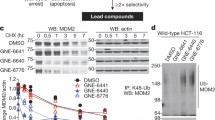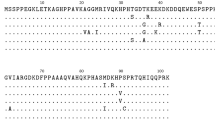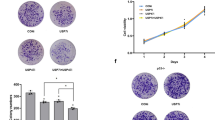Abstract
X-linked inhibitor of apoptosis protein (XIAP), a leading member of the family of inhibitor of apoptosis (IAP) proteins, is considered as the most potent and versatile inhibitor of caspases and apoptosis. It has been reported that XIAP is frequently overexpressed in cancer and its expression level is implicated in contributing to tumorigenesis, disease progression, chemoresistance and poor patient-survival. Therefore, XIAP is one of the leading targets in drug development for cancer therapy. Recently, based on bioinformatics study, a previously unrecognized but evolutionarily conserved ubiquitin-associated (UBA) domain in IAPs was identified. The UBA domain is found to be essential for the oncogenic potential of IAP, to maintain endothelial cell survival and to protect cells from TNF-α-induced apoptosis. Moreover, the UBA domain is required for XIAP to activate NF-κB. In the present study, we report the near complete resonance assignments of the UBA domain-containing region of human XIAP protein. Secondary structure prediction based on chemical shift index (CSI) analysis reveals that the protein is predominately α-helical, which is consistent with the structures of known UBA proteins.
Similar content being viewed by others
Explore related subjects
Discover the latest articles, news and stories from top researchers in related subjects.Avoid common mistakes on your manuscript.
Biological context
The covalent conjugation of ubiquitin to target proteins influences various cellular processes, including NF-κB signaling, DNA repair and cell survival. The most common mode of regulation by ubiquitin-attachment involves specialized ubiquitin-binding proteins that bind to ubiquitylated proteins and link them to downstream biochemical processes. Unraveling how the ubiquitin-message is recognized is essential because aberrant ubiquitin-mediated signaling contributes to tumor formation. Recent evidence indicates that inhibitor of apoptosis (IAP) proteins are frequently overexpressed in cancer and their expression level is implicated in contributing to tumorigenesis, disease progression, chemoresistance and poor patient-survival. X-linked inhibitor of apoptosis (XIAP), belonging to an evolutionary conserved family of inhibitor of apoptosis protein (IAP), is involved in diverse cellular functions including caspase inhibition, receptor signaling activation and ubiquitylation of proteins for proteasomal degradation. XIAP is a leading family of IAP proteins and it is considered as the most potent and versatile inhibitor of caspases and apoptosis. Therefore, XIAP is one of the leading targets in drug development for cancer therapy. XIAP is characterized by the existence of three baculoviral IAP repeat (BIR1–3) at the N-terminus and a Really Interesting New Gene (RING) domain (Schimmer et al. 2006) at the C-terminus. Yet, the long stretch of sequence linking the BIR1–3 domains to the RING domain has no reported structure or function until recently. Previous investigations showed that the inhibitions of effector and initiator caspases by XIAP are accomplished by BIR2 and BIR3 domains, respectively (Eckelman et al. 2006), while the BIR1 domain plays a role in mediating the activation of NF-κB pathway via interaction with TAK1 (Lu et al. 2007). The RING domain in XIAP functions as an E3 ubiquitin ligase to regulate the proteasomal degradation of a number of cellular proteins, including caspases and XIAP itself (Vaux and Silke 2005). Recently, an evolutionary conserved ubiquitin-associated (UBA) domain was identified within the linker region in between the third BIR domain and RING domain of c-IAP1, c-IAP2 and XIAP. Subsequent studies demonstrated that the UBA domain in XIAP binds to Lys 63-linked polyubiquitin and plays role in signaling process, leading to NF-κB activation and cell survival (Gyrd-Hansen et al. 2008). A later site-directed mutagenesis study further highlighted the importance of a conserved MGF loop in the UBA domain of cIAP-1 in mediating the interaction with monoubiquitin (Blankenship et al. 2009). The identification of the UBA domain in XIAP not only provides new insights for understanding the underlying molecular mechanism of the functions of XIAP but also lead to a new potential drug target site on the XIAP protein. The goal of our study is to determine the complex structure of UBA domain of XIAP with mono/poly-ubiquitin by NMR spectroscopy. As a first step of the structure determination process, we reported the backbone and side-chain resonance assignments of the newly identified UBA-domain containing region (UBA-XIAP) in human XIAP.
Methods and experiments
Cloning, expression, and purification
The DNA fragment, encoding the UBA domain-containing region (amino acids 357–449, XIAP357–449, corresponding to residues 12–104 in current study) of XIAP (accession number NP_001158), was cloned into a bacterial expression vector, pET-H. Plasmid pET-H was modified from pET-32a (+) (Novagen), in which the nucleotide sequences encoding the thioredoxin-tag and S-tag were deleted. The resulting construct had an N-terminal (His)6-tag. Recombinant (His)6-tag UBA-XIAP was expressed in Escherichia coli BL21 (DE3) cells in M9 medium supplemented with 2.0 g/l [U-13C] glucose and 1.0 g/l 15NH4Cl (Cambridge Isotopes Laboratory) after 0.3 mM IPTG induction at 25°C for 16 h. For protein purification, the harvested cells were resuspended in 50 mM Tris–HCl pH 7.6, 300 mM NaCl and 1 mM PMSF. It was lysed using sonication, and followed by centrifugation to remove cell debris. Soluble (His)6-tag UBA-XIAP was affinity-purified by using HiTrap chelating HP columns (GE Healthcare). The (His)6-tag was cleaved by thrombin and the digested protein mixture was further purified by size exclusion chromatography on Hiload Superdex 75 prep grade (16/60) column (GE Healthcare). The purity of the (His)6-tag UBA-XIAP was estimated to be over 95% by SDS–PAGE.
NMR experiments
NMR samples were prepared in buffer containing 20 mM Bis-TrisHCl pH 6.7, 100 mM NaCl, 5 mM d10-DTT and 1 mM PMSF in 90% H2O/10% D2O. The final concentration of the protein was 0.7 mM. NMR spectra were acquired at 298 K on a Bruker Advance 600 MHz NMR spectrometer equipped with a TCI cryoprobe. Proton chemical shifts were referenced to TSP (0 ppm), while 13C and 15N chemical shifts were referenced indirectly, using the gyromagnetic ratios of 15N, 13C and 1H (15N/1H = 0.101329118, 13C/1H = 0.251449530). Backbone resonances were assigned from 2D 1H–15N HSQC, 3D HNCO, 3D HN(CO)CACB, and 3D HNCACB spectra. Aliphatic side-chain resonances were obtained from 2D 1H–13C HSQC, 3D HCCH-TOCSY, and 3D HCCH-COSY spectra. The 2D (HB)CB(CGCD)HD and 2D (HB)CB(CGCDCE)HE spectra were used to assign the aromatic side-chain protons. All NMR data was processed using XWINNMR software (Bruker GmbH), and analyzed with SPARKY (Goddard and Kneller 1993).
Assignments and data deposition
The 2D 1H–15N HSQC spectrum of UBA-XIAP, with assignment indicated, is shown in Fig. 1. A total of 96.7% of backbone and side-chain 1H, 15N and 13C resonance assignments were obtained, including 99.2% of backbone assignments (except for HN, N of Gly1 and Ser2 and N of Pro15 and Pro29) and 95.0% side-chain assignments. All chemical shift assignments of UBA-XIAP have been deposited in the BioMagResBank (http://www.bmrb.wisc.edu) under the accession number 16478. The secondary structure of UBA-XIAP was predicted using chemical shift index (CSI) analysis, which were generated using 1Hα, 13Cα,13Cβ and 13C′ chemical shifts (Fig. 2; Wishart and Sykes 1994). It was predicted that the protein under study is primarily composed of four α-helices. The arrangement of the first three helices (α1–α3, residue 30–76, XIAP375–421) closely resembles other members of the UBA superfamily. The last helix (α4) does not associate strongly with the first three helices (α1–α3) according to the analysis of 3D 15N-edit NOESY-HSQC spectrum.
References
Blankenship JW, Varfolomeev E, Goncharov T et al (2009) Ubiquitin binding modulates IAP antagonist-stimulated proteasomal degradation of c-IAP1 and c-IAP2(1). Biochem J 417:149–160
Eckelman BP, Salvesen GS, Scott FL (2006) Human inhibitor of apoptosis proteins: why XIAP is the black sheep of the family. EMBO Rep 7:988–994
Goddard TD, Kneller DG (1993) SPARKY 3. University of California, San Francisco
Gyrd-Hansen M, Darding M, Miasari M et al (2008) IAPs contain an evolutionarily conserved ubiquitin-binding domain that regulates NF-kappaB as well as cell survival and oncogenesis. Nat Cell Biol 10:1309–1317
Lu M, Lin SC, Huang Y, Kang YJ, Rich R, Lo YC, Myszka D, Han J, Wu H (2007) XIAP induces NF-kappaB activation via the BIR1/TAB 1 interaction and BIR1 dimerization. Mol Cell 26:689–702
Schimmer AD, Dalili S, Batey RA, Riedl SJ (2006) Targeting XIAP for the treatment of malignancy. Cell Death Differ 13:179–188
Vaux DL, Silke J (2005) IAPs, RINGs and ubiquitylation. Nat Rev Mol Cell Biol 6:287–297
Wishart DS, Sykes BD (1994) The 13C chemical-shift index: a simple method for the identification of protein secondary structure using 13C chemical-shift data. J Biomol NMR 4:171–180
Acknowledgments
This work was supported by grants from the Hong Kong University Research Grant (KH Sze) and the Research Grants Council of Hong Kong for KH Sze (HKU 7533/06 M, HKU 7755/08 M).
Author information
Authors and Affiliations
Corresponding author
Rights and permissions
Open Access This is an open access article distributed under the terms of the Creative Commons Attribution Noncommercial License ( https://creativecommons.org/licenses/by-nc/2.0 ), which permits any noncommercial use, distribution, and reproduction in any medium, provided the original author(s) and source are credited.
About this article
Cite this article
Hui, SK., Tse, MK., Yang, Y. et al. Backbone and side-chain 1H, 13C and 15N assignments of the ubiquitin-associated domain of human X-linked inhibitor of apoptosis protein. Biomol NMR Assign 4, 13–15 (2010). https://doi.org/10.1007/s12104-009-9197-x
Received:
Accepted:
Published:
Issue Date:
DOI: https://doi.org/10.1007/s12104-009-9197-x






